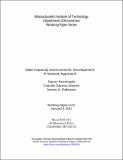| dc.contributor.author | Acemoglu, Daron | |
| dc.contributor.author | Garcia-Jimeno, Camilo | |
| dc.contributor.author | Robinson, James A. | |
| dc.date.accessioned | 2014-01-24T00:05:45Z | |
| dc.date.available | 2014-01-24T00:05:45Z | |
| dc.date.issued | 2014-01-08 | |
| dc.identifier.uri | http://hdl.handle.net/1721.1/84474 | |
| dc.description.abstract | We study the direct and spillover effects of local state capacity using the network of Colombian municipalities. We model the determination of local and national state capacity as a network game in which each municipality, anticipating the choices and spillovers created by other municipalities and the decisions of the national government, invests in local state capacity and the national government chooses the presence of the national state across municipalities to maximize its own payoff. We then estimate the parameters of this model using reduced-form instrumental variables techniques and structurally (using GMM, simulated GMM or maximum likelihood). To do so we exploit both the structure of the network of municipalities, which determines which municipalities create spillovers on others, and the historical roots of local state capacity as the source of exogenous variation. These historical instruments are related to the presence of colonial royal roads and local presence of the colonial state in the 18th century, factors which we argue are unrelated to current provision of public goods and prosperity except through their impact on their own and neighbors’ local state capacity. Our estimates of the effects of state presence on prosperity are large and also indicate that state capacity decisions are strategic complements across municipalities. As a result, we find that bringing all municipalities below median state capacity to the median, without taking into account equilibrium responses of other municipalities, would increase the median fraction of the population above poverty from 57% to 60%. Approximately 57% of this is due to direct effects and 43% to spillovers. However, if we take the equilibrium response of other municipalities into account, the median would instead increase to 68%, a sizable change driven by equilibrium network effects. | en_US |
| dc.description.sponsorship | We are grateful to Alberto Ciancio, Amanda Culp, and Nicolas Idrobo for superb research assistance, and Maria Angelica Bautista, Flavio Cunha, Frank Ditraglia, Andrew Foster, Elena Paltseva, James Poterba, Pascual Restrepo, Xun Tang, Petra Todd, Ken Wolpin, Roman Zarate, participants at the Stockholm School of Economics/SITE conference on Institutional Challenges in Emerging Economies, participants at the George Mason center for Public Choice Seminar, and participants at the RECODE 2013 Meetings in Ottawa, the BREAD/NBER development meetings in Cambridge, the LACEA/LAMES meetings in Mexico City, the MIT Public Finance/labor Workshop, and the UPenn Empirical Micro Workshop for valuable suggestions. Acemoglu gratefully acknowledges financial support from ARO MURI W911NF-12-1-0509. | en_US |
| dc.publisher | Cambridge, MA: Department of Economics, Massachusetts Institute of Technology | en_US |
| dc.relation.ispartofseries | Working paper, Massachusetts Institute of Technology, Dept. of Economics;14-01 | |
| dc.subject | Colombia, economic development, networks, public goods, state capacity | en_US |
| dc.title | State Capacity and Economic Development: A Network Approach | en_US |
| dc.type | Working Paper | en_US |
